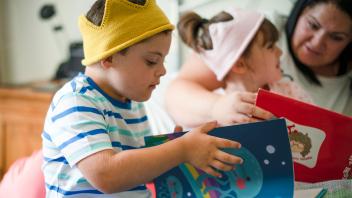Often adults are thrilled when the children in their lives read well about their grade level. I know I was delighted when my son read the first in the series, Harry Potter and the Sorcerer’s Stone (1998), when he was in second grade. Geez, was my child a genius? He certainly seemed to read the words with ease.
As much as I’d like to think so, my son, like most Harry fans, is above all a highly motivated reader. He patiently slugs through the books so he can find out what happened and so he can say to friends that he’s read Harry Potter.
Since then it’s occurred to me that Harry Potter can teach adults about the whole notion of readability. When is a book right for a child?
“Readability” is a term that teachers and librarians use to describe at what grade or ability level a piece of writing can usually be read. Many publishers will include a book’s readability level on the back cover. There are various formulas to determine readability, some based on the number of letters per word or the number of words per sentence. The whole point is to match books to readers. We want to find books that a child can read successfully.
What a child is able to read depends on his or her ability to decode words. This is being able to apply what he knows about the relationship between the sounds he hears and the spelling of words he sees on the page. Reading level also depends on how well a child understands the structure of language. Readers use that information to help them figure out (or decode) unfamiliar words as they read.
I knew that my son could decode most of the words in the first Harry Potter book because I used the “Five Finger Test.” I asked him to read a paragraph from the middle of the book aloud for me and I counted the number of words he couldn’t read (not including proper names or coined words like Quidditch). If he missed more than five words or couldn’t read the piece readily, then the book was probably too difficult.
This is important to know because readers who spend all of their time figuring out words don’t have the mental energy to understand or even enjoy what they’re reading and then become frustrated. Harry Potter is such an action-packed story that it motivates and moves kids along so they willingly tackle words, sentences, and paragraphs that by any other measure would be above their readability level. When a child reads text, she gets practice at decoding, learns to read with less effort and with expression (what reading specialists call fluency), and is more likely to want to read some more!
Since the purpose of reading is not just to be able to decode words but to gain meaning from them, I also wanted to find out if my son understood what he was reading. After the Five Finger Test, I asked him several questions drawn directly from the paragraph. For example, Where did Harry meet Ron? What is the Hogwarts Express? Once I determined that my son could decode the words and understood what he read, there were other considerations to think through.
For example, what about a book’s themes? Is the child mature enough for them? Events in Harry Potter have been disturbing to my son, such as Cedric’s death in Harry Potter & the Goblet of Fire (2000) and Sirius’ fate in Harry Potter & the Order of the Phoenix (2003). Now that my son, like Harry, Hermione, and Ron, is older, he’s more capable of grappling with these issues than when he first met Harry Potter.
The Harry Potter books have become a shared experience for my son and me. We talk about the characters, their personalities, and the books’ themes. We return frequently to Harry Potter & The Sorcerer’s Stone and Professor Dumbledore’s admonition about the impact of one’s choices. As he considers and discusses, my son gains deeper meaning from the books.
As we prepare to read Harry Potter & the Half-Blood Prince, I am reminded of the lessons that the earlier Harry Potter books have provided me about reading and readability:
- Interest and motivation are key to reading; reading is more than just decoding words.
- Reading begins with decoding words with ease. The Five Finger Test can help determine whether a child is able to successfully read the book independently.
- Asking questions about the story can help adults determine whether a child comprehends what he or she reads.
- Some books are too mature for readers regardless of their ability to decode the words and read them fluently. Themes can be difficult or beyond a child’s experience, making the book tough for readers to handle.
- Books grow with readers. Rereading books offers opportunities for greater insight and practice with reading text fluently.
- Books like Harry Potter can be a shared experience that builds community of readers.
So, here’s to Harry Potter and the hope that you and the children in your lives find your own magic in reading!
